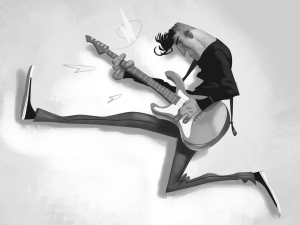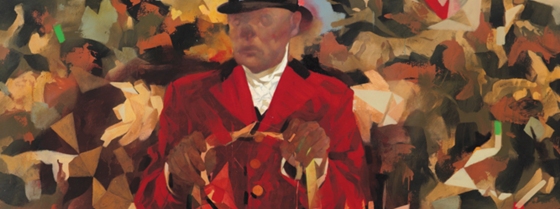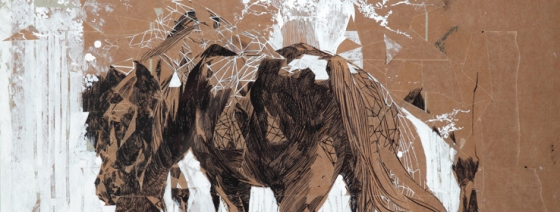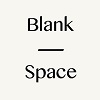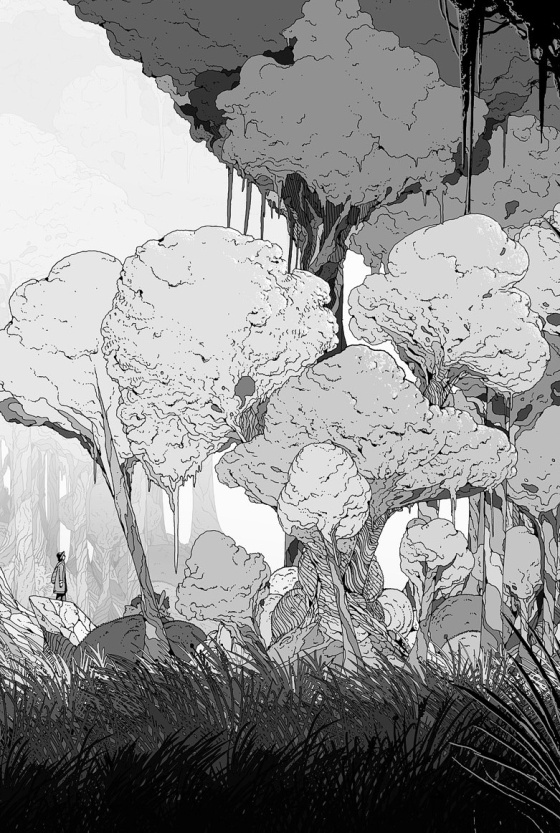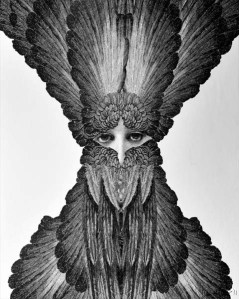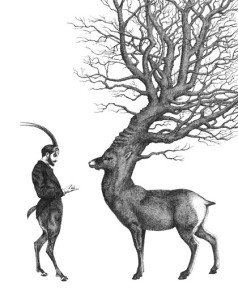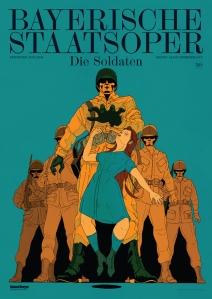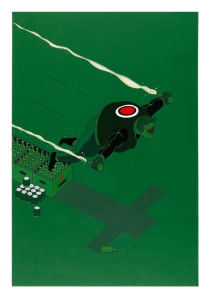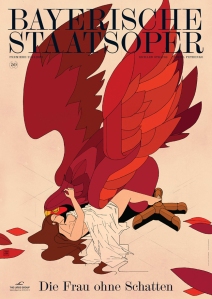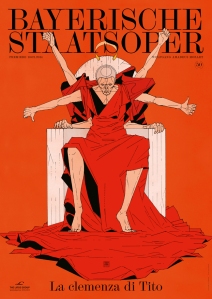In special one-two-punch, (and as an appeal for clemency for not having posted since August!), we bring you Neil Ross, both in splendid visual format as well as an exclusive interview for your perusal.
(I thought we posted his work previously, seeing as how long I have been using his work as my desktop background I assumed I had talked about him by now, but apparently not!)
I found him through his personal work, but most people may recognize his work from the new Tron: Uprising series, as well as such hits as Hotel Transyvlania, Prince of Persia, Corpse Bride, and more. His work combines hyper abstract shapes with representationalism that I haven’t seen anywhere else – where your mind is given just enough information to imagine what it is meant to see, but when under closer observation there are simply thousands of linear designs that move your eye in an overwhelming pattern. It is beautiful, and I am happy to be able to talk more with him about his process and past.



———-
1) Would you mind explaining your history, both any possible education and inspiration? Your work is wonderfully unique and it’d be great to learn how you came upon such a cool style.
I grew up on the Northumberland coast. It was a landscape of chimney stacks, ruined castles, pit heads, islands with abandoned hermitages, mudflats with derelict ironworks. The first art I liked were illustrations of birds, beasts, prehistoric reptiles and a comic called Creepy Magazine.
At the age of about ten I found a pocket-sized book on the Surrealists that cast a spell on me. Here were the things seen with the inner eye. I did not know you were allowed to do this. This was my introduction, although unaware of it at the time, to Dali’s ‘paranoid-critical’ position. In fact, I can see now that I have a persistent fascination with grand paranoiac theories, narratives and people.
I did Graphic Design at art school and then spent a year or three doing badly paid illustrations for advertising agencies in Manchester. After a spell at Cosgrove Hall Films I moved to London and got a job at Richard Williams Animation on Soho Square. This was where drawing, painting and film-making came together for me.
Dick Williams was brilliant, eccentric and ran things like an artist’s studio – not like a business whose economic base was making TV commercials. This waywardness was part of Dick’s appeal and I found him to be a very stimulating and charismatic figure although my admiration may not have been apparent to him at the time.
To begin with I was an odd-job man assisting animators and doing background artwork in different styles and different media. It would depend on what the advertising agencies were asking for. I had no ‘style’ of my own. After a while Dick began to give me whole commercials to design. I would work out how things were to look and what media we’d use, then I would team up with an animator and we’d wade through the thing together until it was done. In those days Soho ran on beer, tobacco and hash. We sucked these tarry fuels into ourselves and stayed up all hours drawing and squinting through the gas. It was a good time.
Dick had unusual reasons for firing people. You could be ousted for “… only coming in to use the toilet.” I was booted out for “… bringing my illegitimate children into the studio.” (Actually, I have one child and she isn’t illegitimate, although I did bring her in a couple of times.) I don’t hold it against him. He was a demanding boss, I respect his paranoia and, anyway, I was re-hired when things cooled down and he saw that I was not the cause of whatever had got the shit to hit the fan.
Eventually I did leave of my own accord. It was unwise move. I entered into a dark period. I made background paintings for animated commercials from pastels and hairspray. There was a demand for such things. But it was a demand that I was increasingly unwilling to fulfil so I enrolled at the University of London and studied History with the hope of finding some relief from my misery in the workings of the past.
Out of the blue I got an offer to work on a feature film about Jewish mice in the Wild West. I accepted without hesitation and climbed aboard a long, steep learning curve with plenty of opportunity to see things from the paranoid-critical position.
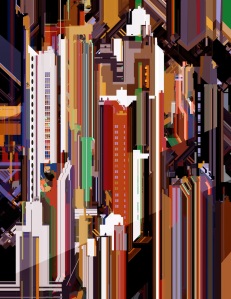
2) Your work is generally non-figurative, or at least the focal point is of a layout. Many of our students talk about how all they want to draw are humans and never practice backgrounds or layouts, even for works in comics or illustrations where jobs aren’t divided into so many titles such as background and character design. Do you have any advice for how to get interested in this field and where you find your motivation?
I see why you say that. It’s true that the imagery I’ve been concerned with in my personal work in recent times is – I’d first say – ‘topographical’ but then ‘topomaniacal’ or ‘topogigamist’ might be more appropriate. I’m motivated by the city I see around me. When I came to London it seemed to be a place that was solidly unchangeable but now things change every day – demolition and construction goes on all the time. The old East End is now a theme park of architectural fashions and urban recovery schemes. My pictures depict built space. It may all be what Rem Koolhaas has called ‘Junkspace’ but I’m happy to find myself in it. Sometimes the pictures are based on a particular place, sometimes not. I improvise and always hope to find more than I have originally imagined. After an hour or two of working on a picture it will take on a life of it’s own and I will try to follow that animus. I am under no obligation to do other than accurately represent the images as they occur. Occasionally I put distinct figures into the images but now I feel inclined to avoid that because they imply narratives that lead me astray. This is not an uninhabited place. There is inner life here, making its way through the rat runs. There is also the client and cult of congestion represented by the Domestic, Art & Utility corporation.
Architects, planners, politicians, ideologues attempt to plan the city but it seems to have its own theorem. The city itself may be the dominant life form of the future. We may inhabit it like tiny mammals in the Jurassic. A calamity may have occurred. What remains is unredeemed. The city seems to re-build itself on top of itself. Some structures are familiar: offices, apartments, balconies, stations. Others are hard to identify. What activities do they contain?
This is an on-going project that I’m working on with the writer, Mark Holloway. Eventually it will be a book.
On students…
Students who are primarily interested in drawing humans are onto the right thing. Once they’ve got their life drawing skills down they can move onto something else….. If they want to. If you only wish to draw the human form then animation seems the job for you. If you want to do comics then you probably need a sense of place or a collaborator who has one, but come to think of it, I can’t imagine an artist who isn’t interested in the way the world looks.

3) What is the goal of each of your pieces? Do you aim for a focal point, a general atmosphere or a contrast of colors, for example? Does this differ for your personal work?
I’ve covered some of this above but, speaking practically, I’m looking for an abstract composition. I often begin with a very simple thumbnail in black and white and one gray tone ONLY. The action and play of light is intrinsic to making a composition. You can learn a lot about composition by looking at pre-war black and white movies. Once the German craftsmen made their way into Hollywood in the late 20’s bringing the ideas of Expressionist Cinema things began to take form. Contemporary camera work is not so instructive because they move around too much. I’m not saying there isn’t great composition in today’s cinematography but it pays to go back to the source.
Colours? Well, I like yellow and red and blue.

4) It is easy for the eye to get mesmerized by your shapes and how abstract the designs can be. At the same time, a lot of your textures take on a water color look. Both of these are fairly traditional techniques – so how do you combat the idea that digital painting isn’t a ‘real’ form of art?
I sometimes use patches of watercolour or acrylic that I paint and scan to make into ‘brushes’. Working in Photoshop lies somewhere between painting and photography. When I was an art student I spent hours fooling around in the darkroom with exposures and developing times (this was all pre-digital of course). One of the drawbacks with pixel-based artwork is the closer you get in to it, the less it’s interesting. This is not true of artwork made from ‘traditional’ materials, neither is it true of non-digital photography. Go close in on a painting by Vermeer or a photograph by Lartigue and new worlds begin to emerge before your eyes. So I experiment with grain and grunge to break up the surface and allow suggestions to occur.
Most digital art is produced on the way toward something else. I mean that it is a designer’s tool. The end result will be not the digital painting but something else. The digital paint stage is just part of the process. The medium was not meant to make art in some grand sense. But even so, you can use it to make art, why not? Art is not a fine thing, it’s just another thing. However, there are long standing hierarchies in the art game. Oil paint is higher than water colour, portraiture is higher than still life and so on. In this sense, digital painting is considered to be very low ‘genre’. The folks out there are a little suspicious of digital paint. They’re not sure we’re putting the hours in. Perhaps we just type in stuff and go off to the pub.
When it comes to my personal work I have certain rules. I don’t photo-bash and I don’t use software that imitates painterly brush strokes. I’m not a purist and these techniques are quite OK for working on movies and games – whatever works, works. But they won’t get me the graphic clarity that I like. I’m looking for images that are worth more than a glance so, increasingly, I’m aiming to make a very complex image.
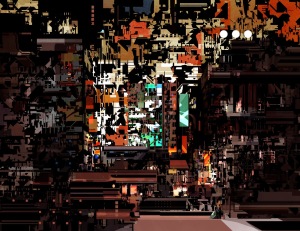
5) 5 Greatest Inspirations and Motivators (as we are an artist’s inspiration blog)
Moebius (How can you avoid him.)
Lebbeus Woods (His writings and ideas as well as the exquisite drawings.)
Milton Glaser (The first graphic designer to hold my attention. I’m still delighted by his work.)
Felix Vallotton.
Jacques Majorelle.
I have to cheat and add a joker to my hand: Dali – more for his ideas than his paintings.
——
Check out more of his work at the links below.
http://limbolo.blogspot.no/
http://www.limbolo.net/
